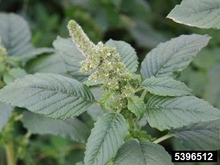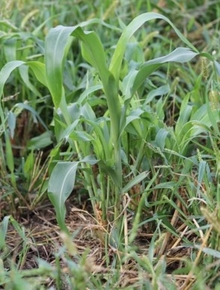Quick facts
- Common lambsquarter, redroot pigweed, curly dock and sorghum-sudangrass are common nitrate accumulators that may appear in horse pastures or hay.
- Nitrates are compounds that can cause toxicity in horses by reacting and limiting a horse’s oxygen in the bloodstream.
- Young growing plants and plants recently fertilized with nitrogen tend to be higher in nitrates.
- Signs of toxicity include difficulty breathing, weakness and bluish mucous membranes.
- Using herbicides on young plants is the best way to control these perennials.
Nitrates are compounds that can convert to another compound, nitrite, in the gut of animals. If too much nitrite enters the animal’s bloodstream, it will inhibit the animal’s oxygen use. If horses eat plants high in nitrates it can lead to toxicity (poisoning).
Plant nitrate content tends to be higher:
- In young, rapidly growing plants.
- In nitrogen-fertilized plants.
- After cloudy days.
Research shows that feeding hay containing 1.5 to 2 percent nitrate to pregnant and non-pregnant mares results in normal foals, even though the mares had higher than normal levels of nitrate in their blood samples.
Signs of poisoning
- Difficulty breathing
- Bluish-colored mucous membranes
- Weakness
- Tremors
- Possibly death
Exposure to nitrate has been related to goiter because nitrate may interfere with iodine. Offering horses iodized salt is the most practical means of preventing nitrate-related goiter.
Plants that can be high in nitrates
Each of the following species grows throughout the United States in cultivated fields, pastures and roadsides.
Common lambsquarter
- Grows 3 to 4 feet high.
- Branched.
- Toothed leaves tend to have a white coating on the upper side, especially at the seedling stage.
- Small green flowers.
- It is an annual.
Redroot pigweed
- Grows 3 to 4 feet high.
- Rough and branched stems.
- Dull green, oval-shaped leaves.
- Green, small and prickly flowers.
- It is an annual.
Curly dock
- Grows 1 to 4 feet high.
- Long, wavy green leaves.
- Bunched flowers that turn from greenish to reddish-brown when mature.
- It is a perennial.
Sorghum-sudangrass
- Upright, solid stems grow 2 to 12 feet tall.
- The structure, growth and general appearance are similar to corn.
- It is an annual.
Sorghum-sudangrass has good yield potential for pasture or hay. It grows well during times of high temperature and drought and is usually used as emergency cattle forage. Although it’s not commonly fed or grazed for horses, it can be useful during times of drought when other forage is scarce.
If you buy sorghum-sudangrass during a drought year, test the forage for nitrates before feeding it to your horse. The following places can test hay for nitrate content:
- DHIA (320-352-2028)
- Dairyland (320-240-1737)
- Minnesota Veterinary Diagnostic Laboratory (612-625-8787)
Signs of poisoning
- Difficulty breathing
- Bluish-colored mucous membranes
- Weakness
- Tremors
- Possibly death
Exposure to nitrate has been related to goiter because nitrate may interfere with iodine. Offering horses iodized salt is the most practical means of preventing nitrate-related goiter.
Control weeds to prevent poisoning
Control annual weeds with timely mowing and proper pasture management.
Perennial weeds are hard to control. Timely mowing alone can take a few years before it adequately reduces weed growth. Herbicides can control common lambsquarter and redroot pigweed. You may need to apply herbicide a few times to control curly dock.
Herbicides work best when used while the plants are still small. You may need to hand-pull large plants when the stems become woody and hard to control with mowing and herbicides.
Always follow grazing restrictions and pertinent information stated on the herbicide label.
See Drought and frost concerns for additional information on nitrate.
CAUTION: Mention of a pesticide or use of a pesticide label is for educational purposes only. Always follow the pesticide label directions attached to the pesticide container you are using. Be sure that the area you wish to treat is listed on the label of the pesticide you intend to use. Remember, the label is the law.
Reviewed in 2024





